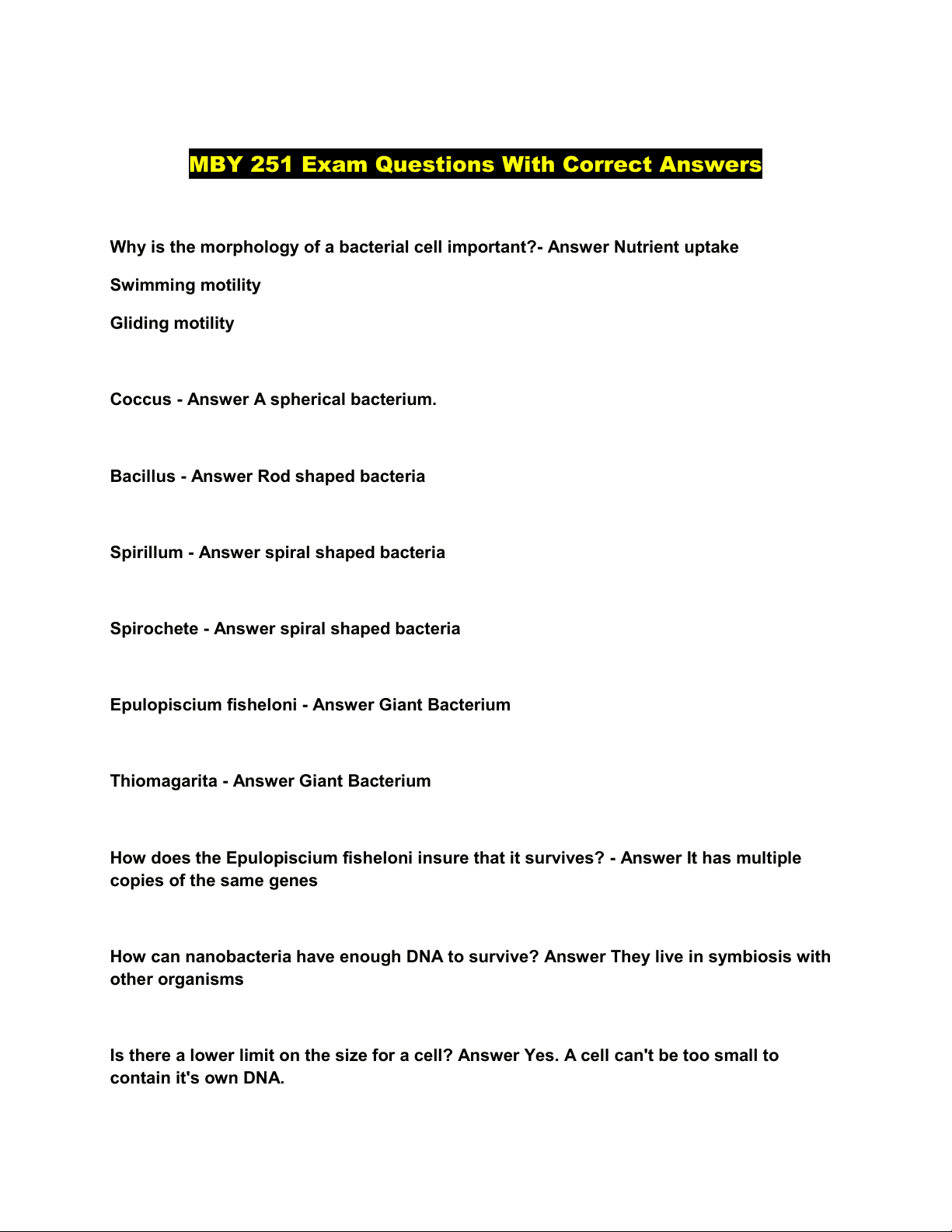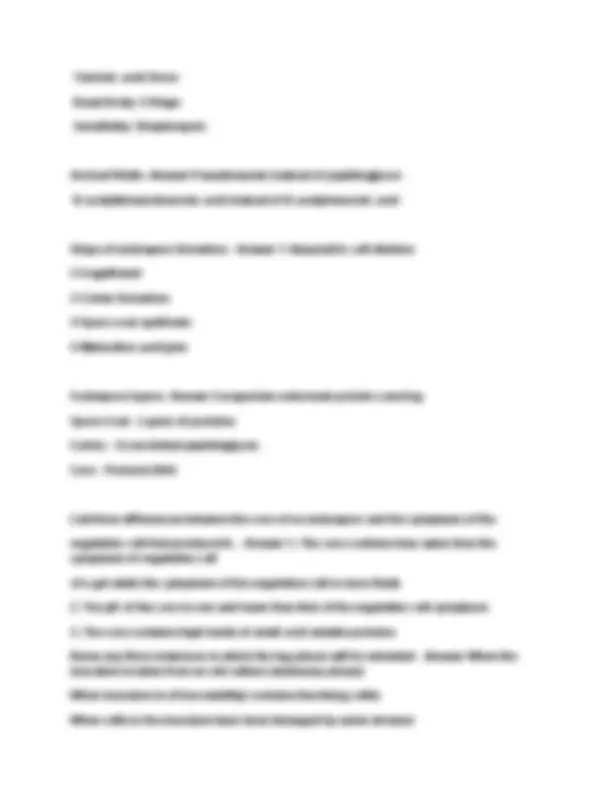










Study with the several resources on Docsity

Earn points by helping other students or get them with a premium plan


Prepare for your exams
Study with the several resources on Docsity

Earn points to download
Earn points by helping other students or get them with a premium plan
Community
Ask the community for help and clear up your study doubts
Discover the best universities in your country according to Docsity users
Free resources
Download our free guides on studying techniques, anxiety management strategies, and thesis advice from Docsity tutors
MBY 251 Exam Questions With Correct Answers
Typology: Exams
1 / 14

This page cannot be seen from the preview
Don't miss anything!









Why is the morphology of a bacterial cell important?- Answer Nutrient uptakeSwimming motility Gliding motility Coccus - Answer A spherical bacterium. Bacillus - Answer Rod shaped bacteria Spirillum - Answer spiral shaped bacteria Spirochete - Answer spiral shaped bacteria Epulopiscium fisheloni - Answer Giant Bacterium Thiomagarita - Answer Giant Bacterium How does the Epulopiscium fisheloni insure that it survives? - Answer It has multiplecopies of the same genes
How can nanobacteria have enough DNA to survive? Answer They live in symbiosis withother organisms
Is there a lower limit on the size for a cell? Answer Yes. A cell can't be too small tocontain it's own DNA.
Why does the cytoplasmic membrane have to be fluid? Answer Allows movementEasy repair
What is the structure of the cytoplasmic membrane? Answer Phospholipid bilayerFatty acid inward Glyceraldehyde phosphate outward Cell membrane function- Answer Permeability barrierNutrient transport
Peptidoglycan composition - Answer glycan backbone(2 sugars & amino acids) Peptidoglycan sugars- Answer N-acetylglucosamineN-acetylmuramic acid
Peptidoglycan amino acids- Answer Alanine (D&L) Glutamic Acid (D)Lysine / diaminopimelic acid
Gram negative peptidoglycan cross linking- Answer Direct link between DAP & -COOH ofD-alanine
Gram positive peptidoglycan cross linking- Answer Peptide interbridge Properties of bacterial membrane -Answer Ester linkage between glycerol Fatty acid hydrocarbonBilayer membrane
Teichoic acid: NoneBasal Body: 4 Rings Sensitivity: Streptomycin Archael Walls- Answer Pseudomurein instead of peptidoglycan N-acetyltalosaminuronic acid instead of N-acetylmuramic acid Steps of endospore formation - Answer 1-Assymetric cell division2-Engulfment 3-Cortex formation4-Spore coat synthesis 5-Maturation and lysis Endospore layers- Answer Exosporium outermost protein covering Spore Coat - Layers of proteinsCortex - Cross linked peptidoglycan Core - Protects DNA List three differences between the core of an endospore and the cytoplasm of thevegetative cell that produced it. - Answer 1. The core contains less water than the cytoplasm of vegetative cell of a gel while the cytoplasm of the vegetative cell is more fluid)2. The pH of the core is one unit lower than that of the vegetative cell cytoplasm
Psychrophile adaptions - Answer -More a-Helixes than B-Pleated sheets in DNA-Enzymes have more polar and less hydrophobic amino acids -Lipids contain polyunsaturated fatty acids -Contains cryptoproteinsHyperthermophile adaptions - Answer -Proteins have a higher number of ionic bonds -Interior of proteins are hydrophobic-Fatty acids in membranes are long
Effect of heat on Bacteria: - Answer Denatures macromolecules Effect of radiation on Bacteria: - Answer Modifies & breaks DNA Complex Media - Answer Unknown chemical composition Chemically defined media - Answer Exact chemical composition is known Selective media - Answer Contain inhibitors that stop growth of microbes other thantarget
Differential media - Answer Used to distinguish between groups of bacteria Briefly describe how enzymes reduce the activation energy needed for chemicalreactions to take place. -Answer -Enzymes bind the substrate and position it relative to particular amino acid in the activeside in order to form enzyme-substrate complex. -This places strain about the particular bonds inside the substrate and thereby decreasethe activation energy is adequate for the reaction to proceed.
Cytochrome bc1 - Answer Moves e to cytochrome c Cytochrome c - Answer Moves e to cytochrome a & a Cytochrome a & a3 - Answer Reduces O2 to H2O Which four of the electron carriers are involved in generation of the proton motive force,i.e. those involved with pumping out of the protons to the outside of the cell membrane? - Answer 1 Flavoproteins.2 Quinones 3 Cytochrombe bc14 Cytochrome aa
Proton Motive Force (PMF) - Answer Electron Transport Carriers pump H out. EstablishespH & electrochemical gradients, which charges membrane like a battery
Anaerobic Respiration - Answer Uses other electron acceptors than O2 ( e.g.Nitrate(NO3-), ferric iron (Fe3+), sulfate (SO4 2-), carbonate (CO3 2-) to produce energy
Chemolithotrophs - Answer -Uses inorganic chemicals (H2S, H2, Ferrous Iron, NH3) aselectron donors -Uses both ETC & PMF Phototrophs -Answer-Uses CO2 as electron donor -Uses photophosphorylation Salmonella typhimurium -Answer Salmonella
Neissera gonorrhoeae -Answer Gonorrhea Bordetella pertussis -Answer Whooping cough Excrete polysaccharide slime -Answer Cyanobacterium Type IV pili -Answer M. xanthus Gliding-specific proteins -Answer Flavobacterium johnsoniae Protein adhesion complex -Answer M. xanthus Chlamydomanas nivalis -Answer Psychrophiles Pschromonas -Answer Psychrophiles Methanopyrus -Answer Hyperthermophile Picophilus oshimae -Answer Acidophile Bacillus firmus -Answer Alkaliphile Saccharomyces cerevisiae - Answer Can carry out fermentation or respiration Oxygenic photosynthesis - Answer Photosynthesis that oxidizes water to form oxygen;the form of photosynthesis characteristic of plants, protists, and cyanobacteria
Picoplankton - Answer Chlorophyll a & b Purple bacteria - Answer Bacteriochlorophyll a & b Green sulfur bacteria - Answer Bacteriochlorophyll c, d & e Green non-sulfur bacteria - Answer Bacteriochlorophyll cs Helio bacteria - Answer Bacteriochlorophyll g Ammonia monooxygenase - Answer NH3 + O2 + 2H2 + 2e -> NH2OH + H2O Hydroxylamine oxidoreductase - Answer Nh2OH + H2O -> NO2 + 5H + 4e Nitirite oxidoreductase - Answer NO2 + H2O -> NO3 + 2H + 2e Type 1 methanotrophs - Answer -Assimilate C1 cmpds via ribulose monophosphate pathway-Gammaproteobacteria -Disc shaped bundles Type 2 methanotrophs - Answer -Assimilate C1 cmpds via Serine pathway-Alphaproteobacteria -Paired membranesAlong periphery (either one of these)
Three steps to identify bacteria - Answer Phenotypic, chemotaxonomic, genotypiccharacteristics
Homofermentative - Answer producing a fermentation resulting wholly or principally in asingle end product (lactic acid) Bacteria phyla - Answer •Proteobacteria •Actinobacteria •Firmicutes •Bacteroidetes Characteristics of phototrophic bacteria - Answer -Use chlorophyll-like pigments to harvest energy -Transfers energy to membrane bound reaction center-Uses the energy to make ATP Phototrophic bacteria - Answer -Cyanobacteria-Purple Nonsulfur Bacteria -Purple sulfur bacteria-Green sulfur bacteria -Green nonsulfur bacteriaKey genera in cyanobacteria - Answer -Prochlorococcus -Crocosphaera-Synechococcus -Trichodesmium -Oscillatoria-Anabaena Cyanobacteria morphological groups - Answer -Chroococcales.-Pleurocapsales -Oscillatoriales
-Chlorobaculum-"Chlorochromatium"
Green sulfur bacteria characteristics - Answer -Little metabolic versatility-Typically non-motile -Strictly anaerobic anoxygenic phototrophic bacteria Green nonsulfur bacteria key genera - Answer -Chloroflexus-Heliothrix -Roseiflexus Green nonsulfur bacteria characteristics - Answer -Anoxygenic phototrophs -Filamentous bacteria-Gliding motility
Characteristics of Nitrogen-Fixing Bacteria - Answer -Fix Nitrogen gas (N2) into NH3-Contain the enzyme nitrogenase
Nitrogen-Fixing Bacteria key genera - Answer -Mesorhizobium -Desulfovibrio -Azotobacteria Nitrifying and Denitrifying Bacteria characteristics - Answer -Grow by the anaerobicrespiration of inorganic nitrogen to the gaseous products-Facultative aerobes
-Chemoorganotrophs Dissimilative Iron-Reducing Bacteria key genera - Answer -Geobacteria -Shewanella Dissimilative Iron-Reducing Bacteria characteristics - Answer -carry out metal respirationby coupling the oxidation of H2 or organic compounds to the reduction of ferric iron
Dissimilative Iron-Oxidizing Bacteria key genera - Answer -Acidithiobacillus -Gallionella Hydrogen-Metabolizing Bacteria key genera - Answer -Ralstonia -Paracoccus